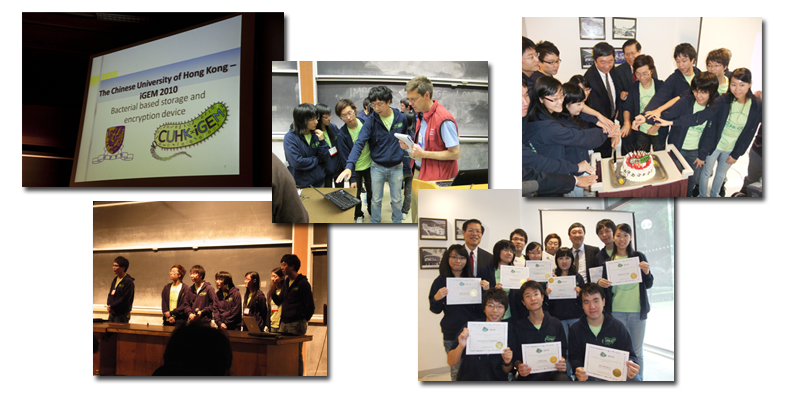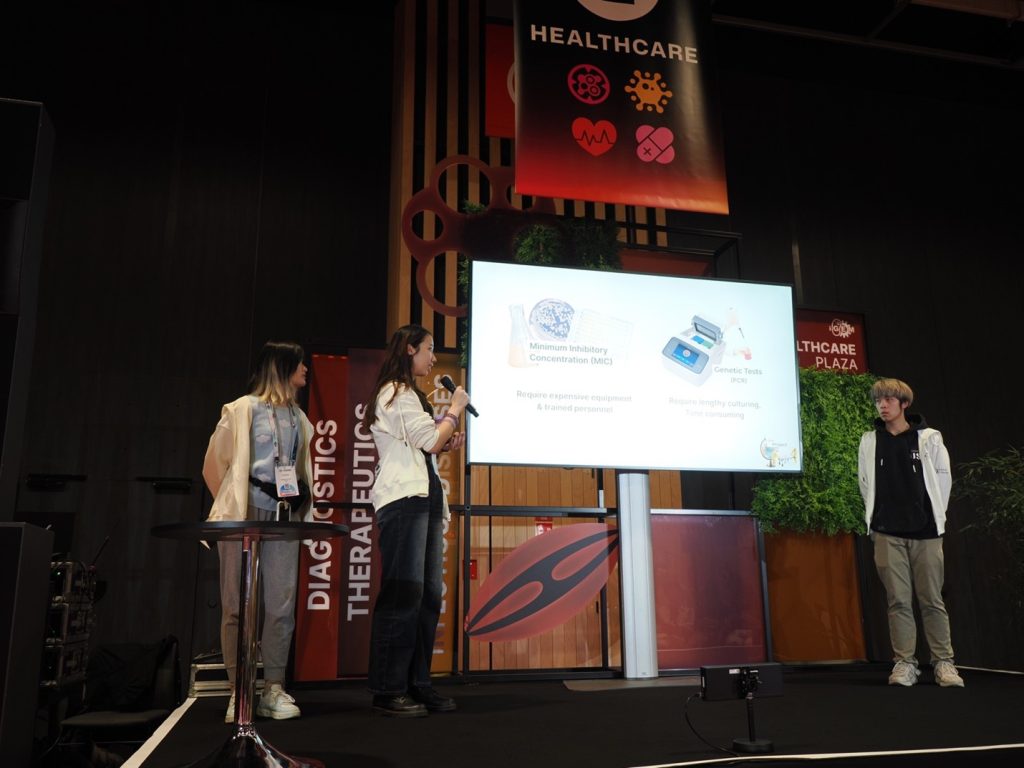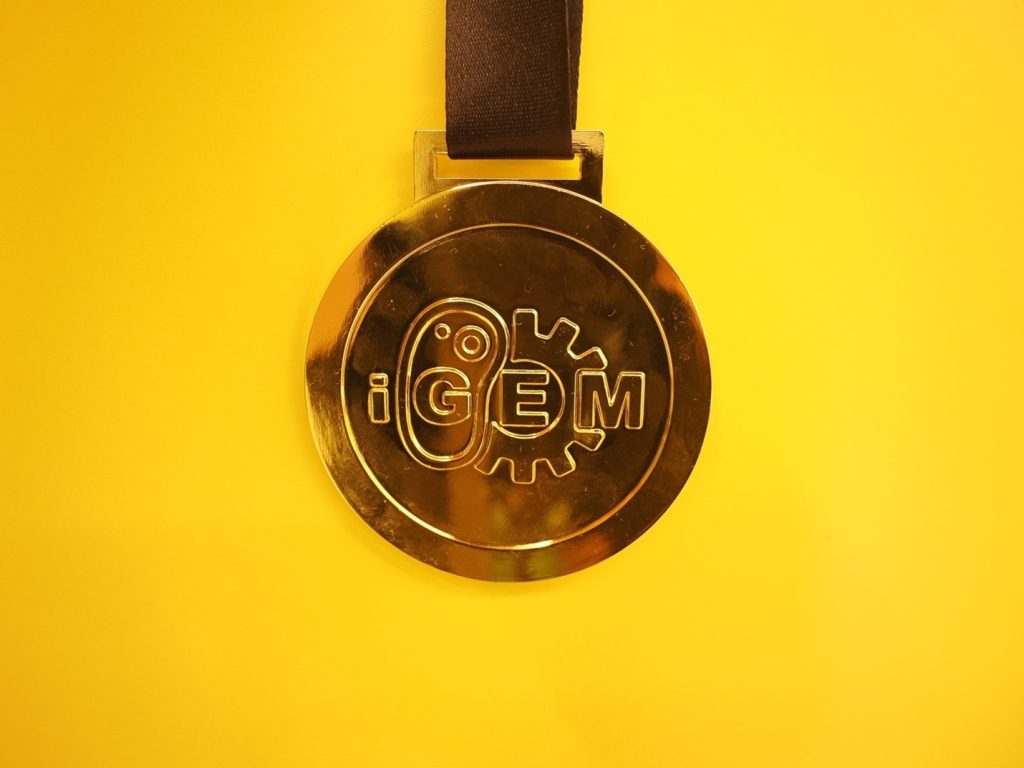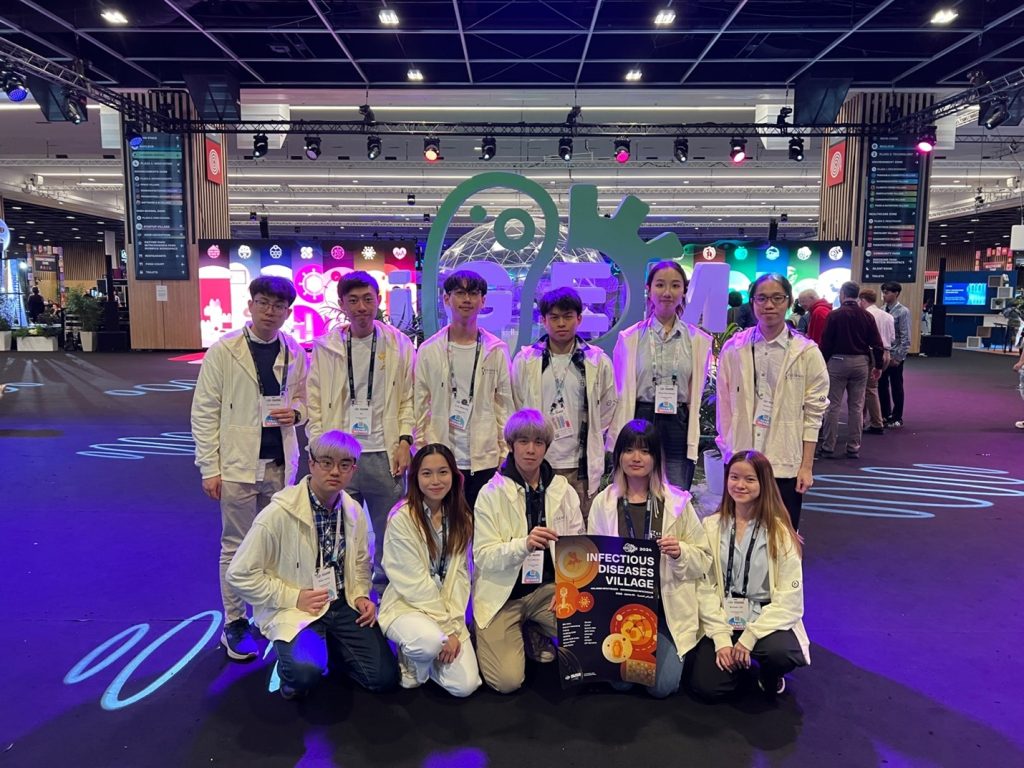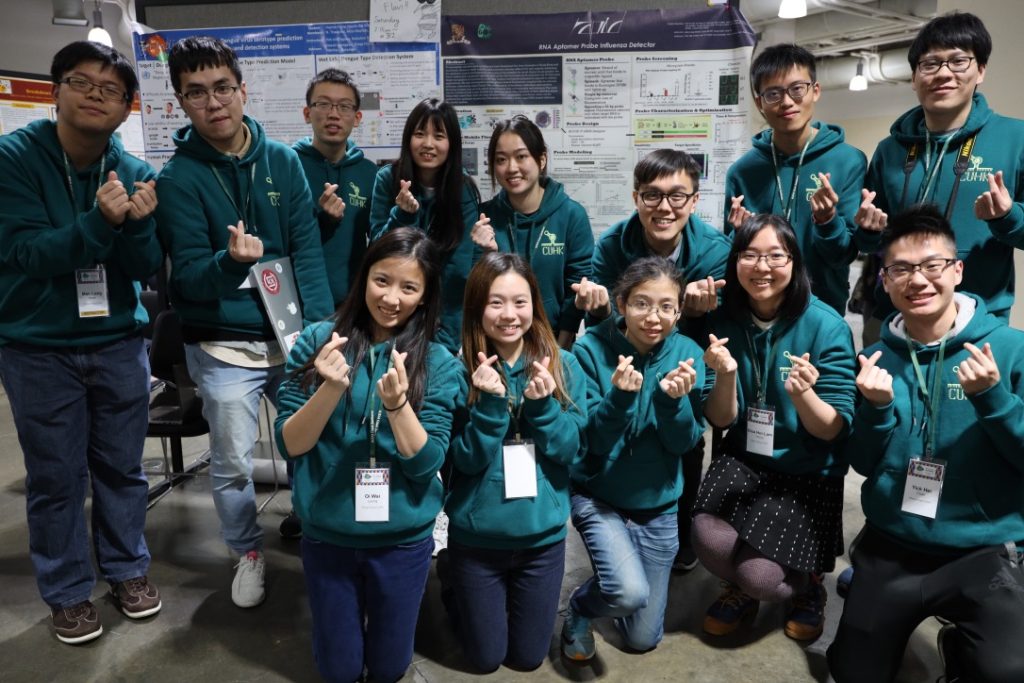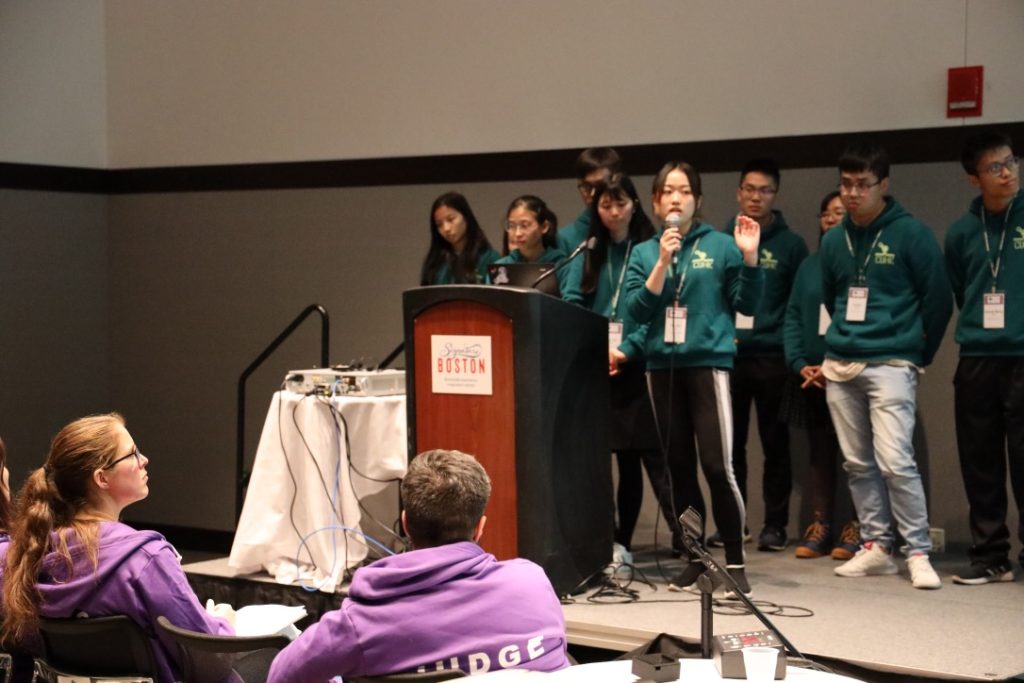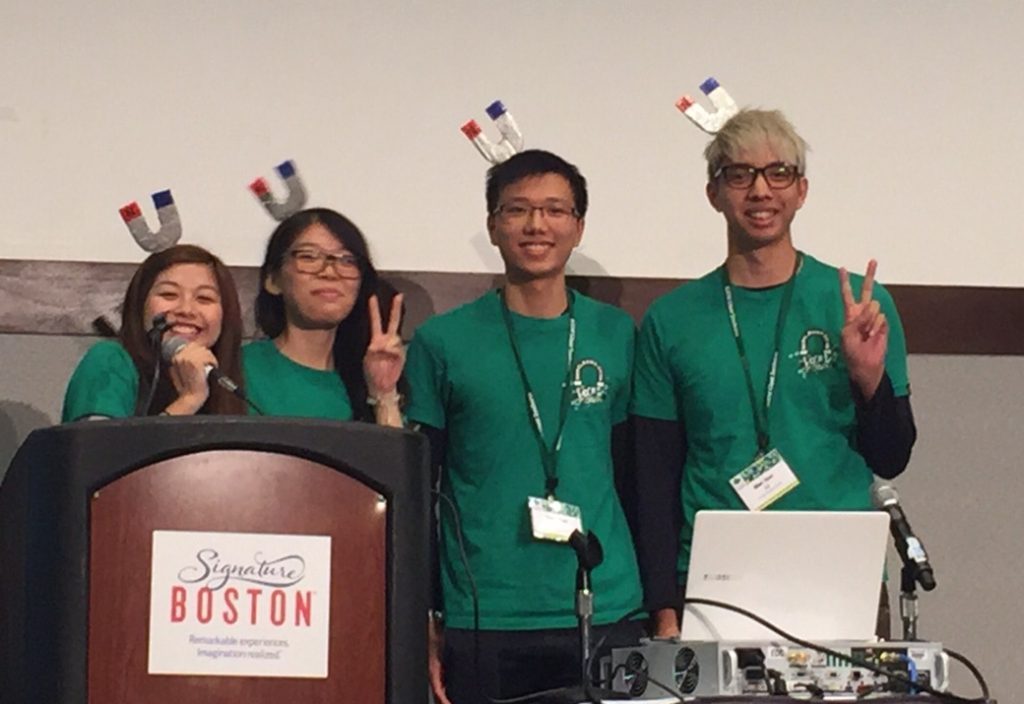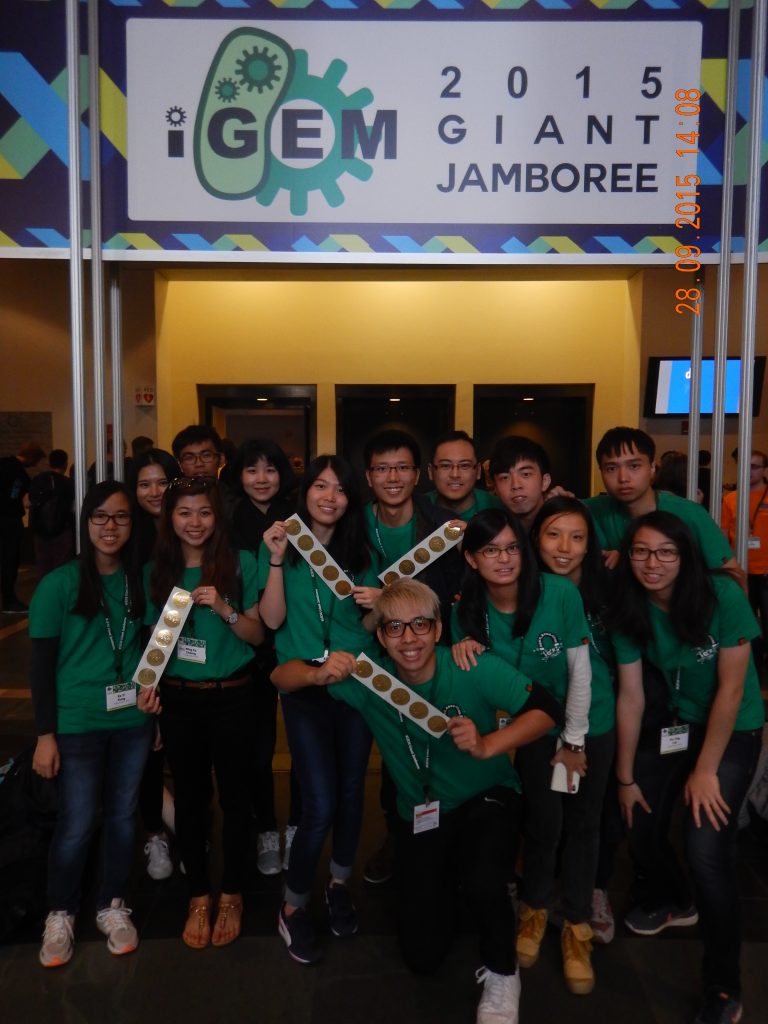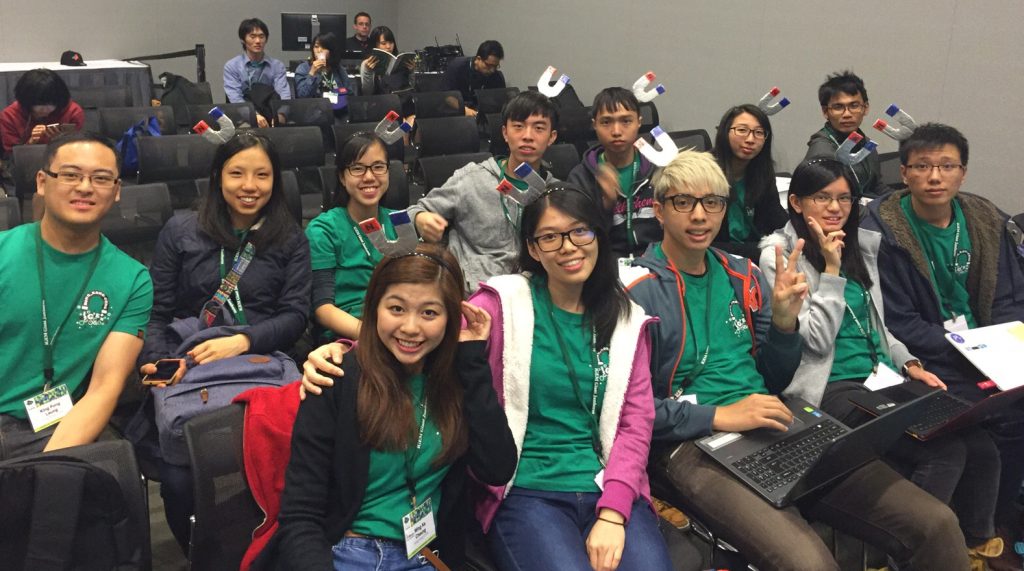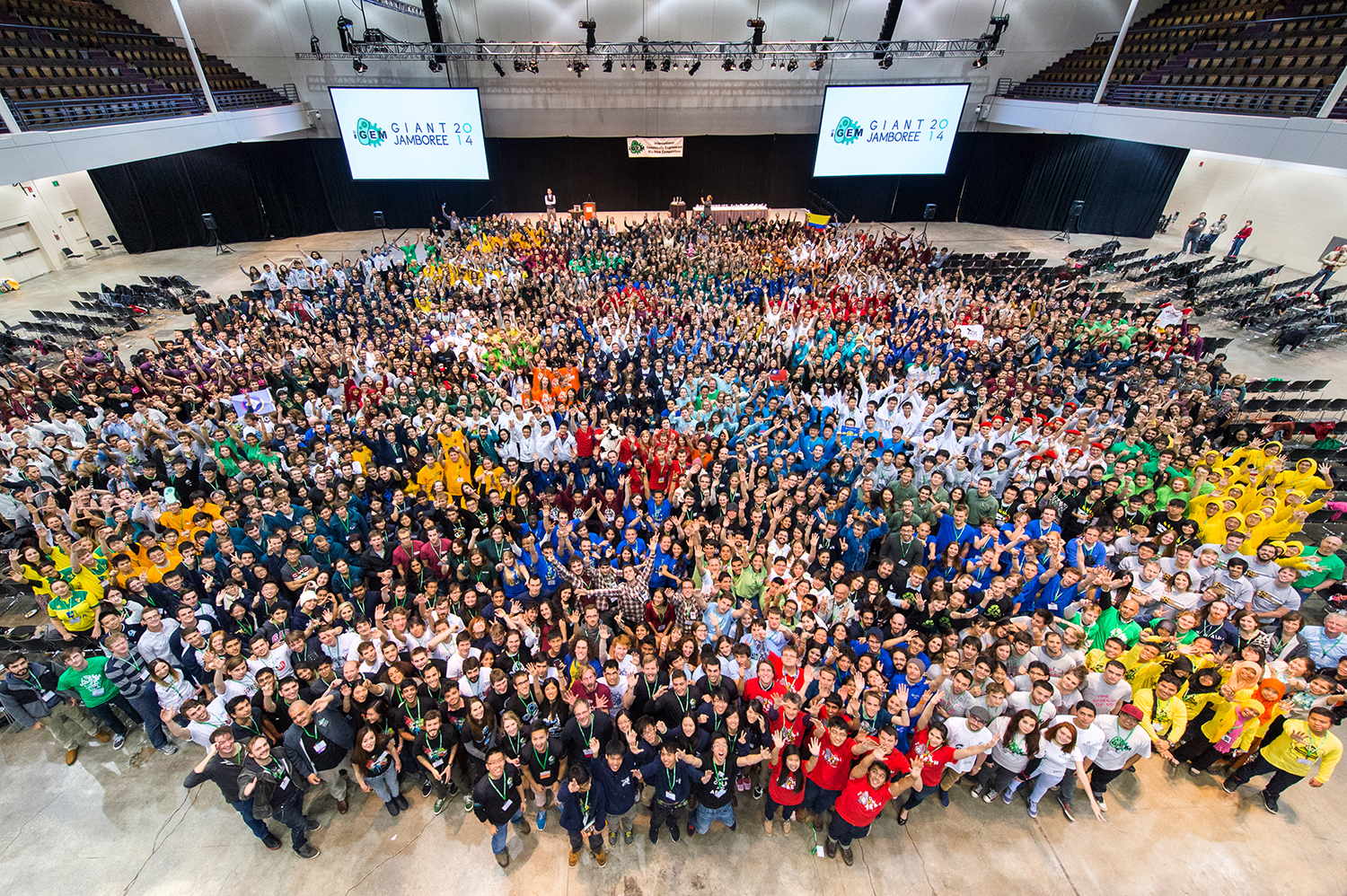iGEM
CUHK Team Wins Gold at iGEM for Innovative Antibiotic Resistance Test
3 Dec. 2024

A team of brilliant young minds from the Chinese University of Hong Kong (CUHK) has made a significant stride in the global fight against antibiotic resistance. The team, composed of students from the School of Life Sciences and Department of Biomedical Engineering, has developed a revolutionary rapid diagnostic test agent called ResiSense.
This innovative technology is poised to transform the detection of antibiotic-resistant infections, particularly those caused by the formidable blaKPC-2 gene. By participating in the prestigious International Genetically Engineered Machine (iGEM) competition, the CUHK team has brought to light a solution that addresses a pressing global health crisis.
ResiSense offers a compelling advantage over traditional diagnostic methods, boasting the following key benefits:
- Rapid Results: Delivering accurate results in as little as 1.5 hours.
- Accessibility: Requiring minimal environmental setup and equipment, making it suitable for remote and resource-constrained areas.
- Affordability: Designed to be cost-effective, ensuring widespread accessibility.
The team’s groundbreaking work has earned them a Gold Medal at the iGEM 2024 Grand Jamboree in Paris, France. This prestigious award recognizes the team’s exceptional innovation, scientific rigor, and potential impact on global health.
The team’s ambitious vision extends beyond the detection of blaKPC-2. They aim to develop a comprehensive suite of rapid diagnostic test agents capable of identifying a wide range of antibiotic resistance genes. By enabling early detection and targeted treatment, ResiSense has the potential to significantly curb the spread of antibiotic-resistant infections and improve patient outcomes worldwide.
This groundbreaking achievement underscores the ingenuity and dedication of CUHK students and the university’s unwavering commitment to fostering innovation and addressing global health challenges.
CUHK Team Develops a Rapid On-Site Method for Detecting Influenza Virus and Wins Gold Award in iGEM Competition
13 Dec 2018

A genetic engineering team of 12 undergraduate students from the Faculty of Business Administration, the Faculty of Engineering, the School of Biomedical Science of the Faculty of Medicine, and the School of Life Sciences of the Faculty of Science at The Chinese University of Hong Kong (CUHK), has been awarded a Gold medal at the international Genetically Engineered Machine (iGEM) 2018 Giant Jamboree held in Boston, USA, for developing a novel rapid test for influenza subtypes. This is the seventh time that a CUHK team has won gold in the annual premier synthetic biology competition. The winning project has extensive potential applications and may help doctors and even the general public to detect the threat of an influenza virus.
The winning project designed by the CUHK iGEM team was named “Rapid: RNA aptamer probe influenza detector” (RAPID). Transmissible diseases such as influenza have threatened the lives of people in Hong Kong and worldwide. However, while cold-flu differentiation remains difficult for non-experts, many people fail to receive appropriate treatment in time. Even if the doctor diagnoses the flu, a laboratory test is still required to confirm its type (i.e., type A, B or C) and subtype (such as H1N1, H5N1 and H7N9). It often takes a day or more and may miss the prime time for epidemic control. The RAPID designed by the CUHK team can distinguish the virus’s type by detecting its RNA target sequence and it takes only around thirty minutes for the results. The detector is small and light. Patients can use it at home to detect whether they are infected with the flu, and seek medical advice in time, which will improve anti-epidemic efficiency.
This novel tool is based on the switchable light-up RNA aptamer, which undergoes conformational change upon hybridisation with another strand of nucleic acid, leading to an observable fluorescent signal. This tool can be modified to detect theoretically any RNA target sequence, including influenza and other viruses’ genome. The CUHK iGEM team designed a mobile phone-based fluorometer to detect the signal of the aptamer, as well as an accompanying software which makes use of the technique of machine learning to analyse the testing result. This tool can make it more convenient for the general public to detect an influenza virus by themselves.
To provide a self-testing tool for the general public to test for influenza when they experience flu-like symptoms, the team distributed questionnaires in local and nearby countries during the preliminary stage of the project. Based on the result, the team realised that there is a real need in the market because the majority of the general public cannot differentiate between the symptoms of flu and cold. Also, people expressed interests in such a device and are willing to pay for it.
The team has also interviewed an epidemiologist, to gain feedback and advice on the project design. As a result, the team has improved the sensitivity of the quick test accordingly, as sensitivity would have the utmost importance for a self-test. Students also interviewed a family doctor to learn more about the existing quick tests for influenza so as to make the tool more competitive than existing tests.
Professor Chan King-ming, one of the instructors of the team and associate professor of the School of Life Sciences at CUHK, remarked, “Students from different majors work together collaboratively, with their own expertise, from designing the hardware to making biobricks and doing experiments as a team. It’s been a great experience for them to compete with other teams from top universities in the Jamboree”
About iGEM Competition
There were 365 teams from around the world participating in this year’s world giant jamboree and, of them, only 114 teams achieved gold.
iGEM is an annual premier synthetic biology competition worldwide for high school, undergraduate and postgraduate students. It was established by the Massachusetts Institute of Technology (MIT) in 2004 to foster students’ learning in synthetic biology, promote collaboration among students and nurture biology talent. Participating teams are required to specify, design, build and test simple biological systems made from standard, interchangeable biological parts. The accomplishments of these student teams often lead to important advances or provide solutions to tackle problems in medicine, food and nutrition, energy and the environment.
香港中文大學(中大)工商管理學院、工程學院、醫學院生物醫學學院及理學院生命科學學院十二位本科生組成的基因工程隊伍,憑著設計快速辨別流感病毒的方法,在美國波士頓舉行的國際遺傳工程機器設計(International Genetically Engineered Machine,簡稱iGEM)世界賽中榮獲金獎。這是中大第七度在該比賽中奪金,成績驕人。
中大隊伍今年的參賽項目為「快速:核酸適配流感探針檢查器」(RAPID: RNA Aptamer Probe Influenza Detector)。流感等傳染病一直威脅著香港以至全球人類健康,但由於初期症狀如咳嗽、發熱等與傷風相似,很多人將兩者混為一談,未能及時對症下藥。即使醫生診斷為流感,亦須在實驗室測試病毒樣本,才可確定病毒類型(即甲、乙或丙型)及其亞種(如H1N1、H5N1及H7N9等)。大部分病毒樣本測試需時一天或更久,可能錯失控制疫情的黃金時間。中大基因工程隊於是研發一套流感病毒快速測試系統,能夠利用病毒的核糖核酸(Ribonucleic acid,簡稱RNA)分辨其種類,約半小時內便有結果。患者僅需要一部智能手機、一個小巧的探測儀和配件,便可安坐家中自行檢測是否染上流感,及時求醫,減少流感的傳播。
這個測試利用了一款螢光核酸適體(Light-up RNA Aptamer)的設計。當改造過的螢光核酸適體與另一核酸分子相配結合時,它的結構會轉變而導致發出可見的螢光,顯示屬於某種病毒的序列是否存在。這款適體的設計理論上能檢測任何一種核酸分子,包括流感及其他病毒的基因序列。中大基因工程隊設計了一個便攜式螢光探測儀用以檢測適體發出的螢光。隊伍亦基於機器學習的方法設計了一個手機應用程式對檢測結果進行分析。這個設計有望幫助普通市民更加方便快捷的檢測流感病毒。
中大基因工程隊在計劃的初期收集了本地及鄰近國家市民的意見,發現大部分受訪者表示不能分辨流感和感冒的症狀,他們對能自行檢測是否患上流感的裝置感興趣,並樂意付款購買。隊伍又諮詢傳染病專家,專家認同該產品有潛質可幫助市民在家中進行自我測試,而隊伍也根據專家的建議改善產品設計,讓產品更貼近使用者的需要。隊伍亦有訪問家庭醫生,了解現有的快速流感測試,以求令隊伍的產品更有競爭力。
基因工程隊的指導教授之一、中大生命科學學院副教授陳竟明教授表示:「這次比賽,主修不同科目的同學都能夠各自發揮所長,由研究如何開發產品設計,到設計生物零件,均操作實騐,各司其職,亦合作無間。同學們參加這次比賽,亦學會了做報告和演說技巧,與其他來自頂尖大學的學生切磋交流,獲益良多。」
iGEM比賽簡介
今年共有365隊來自世界各地的隊伍參賽,只有114隊奪得金獎。iGEM比賽為國際合成生物學界每年一度的盛事。iGEM由麻省理工學院於2004年創立,旨在促進學生在合成生物學的學習、交流與合作,以培養合成生物學人才。比賽隊伍須利用基本且可交替的生物部件,設計及建立有效的生物系統。參賽作品水平超卓,有效推動解決醫學、食品營養、能源及環境等方面難題的硏究。
2018年12月13日
- Press Release
- Team Members
- Media:
hk01
CUHK Team Develops a Rapid On-Site Method for Subtyping Influenza A virus and Wins Gold Award in iGEM competition
4 Dec 2017

A genetic engineering team of 15 undergraduate students of life science and biomedical engineering at The Chinese University of Hong Kong (CUHK), has been awarded a Gold medal at the international Genetically Engineered Machine (iGEM) 2017 Giant Jamboree held in Boston, USA, for developing a novel rapid test for an influenza subtype. The winning project has extensive potential applications and may help fight the growing threat of a bird flu epidemic. This is the fifth time that a CUHK team has won gold in the annual premier synthetic biology competition.
The winning project designed by the CUHK team was named “Dr. Switch: A Rapid On-Site Method for Subtyping Influenza A virus”. Presently, diagnostic testing for viruses is only available in the laboratory and it often takes a day or more for the result to come back, due to lengthy transportation and testing time. There is a rapid test which is quicker, but the result is preliminary (Only type A, B or C) which cannot show the subtype of the virus (H1N1, H5N1 or H7N9, etc.). The CUHK iGEM team has developed a rapid test system that can distinguish the subtype of the Influenza A virus. The test can be done on-site in animal farms, at borders or in markets, and the results will come within hours, which will improve anti-epidemic efficiency.
This novel test is based on the Toehold Switch mechanism that, in theory, could detect any RNA target sequence, including the Influenza A virus. A Toehold switch, acting as a biosensor, will undergo conformational change and gene expression, which will produce a visible signal like colour change, in the presence of a specific RNA target – known as a trigger. It was recently used for the detection of Zika.
The CUHK iGEM team is the first group to have developed a web-based tool (http://2017.igem.org/Team:Hong_Kong-CUHK) to help researchers designing Toehold Switch, and applied this method to detect influenza viral subtypes that could work in hours. Their project was nominated for the Best Diagnostic Project, together with the University of Oxford and the Ecole Polytech Fed de Lausanne (EPFL). The prize went to Oxford in the end.
Students have interviewed various stakeholders, including medical experts, government organisations and most importantly, poultry workers. They hoped the test can cater more to the needs of users. For example, the students at first estimated that poultry workers would be interested in conducting virus tests for their own poultry, which could reduce the financial losses caused by the spread of bird flu. However, when they visited a poultry farm owner, they received an answer different from what they expected. The owner’s view was that the test should be conducted by the government or an independent inspection body. Students then consulted government organisations such as the Department of Health, and the Agriculture, Fisheries and Conservation Department. All these visits allowed students to further understand the procedures for influenza testing.
Prof. Chan Ting Fung, one of the instructors of the team and associate professor of the School of Life Science at CUHK, remarked, “The enthusiasm of the undergraduate students for scientific research is admirable. They have spent just over a year, selected their topic of research, failed many times, but finally they achieved a remarkable result. They also showed team spirit and demonstrated the importance of combining molecular biology and engineering knowledge. I hope they will continue to uphold their enthusiasm, participate in scientific research and contribute to society.”
About iGEM Competition
There were 331 teams from around the world participating in this year’s world giant jamboree, and of them only 108 teams achieved gold.
iGEM is an annual premier synthetic biology competition worldwide for high school, undergraduate and postgraduate students. It was established by the Massachusetts Institute of Technology (MIT) in 2004 to foster students’ learning in synthetic biology, promote collaboration among students and nurture biology talents. Participating teams are required to specify, design, build and test simple biological systems made from standard, interchangeable biological parts. The accomplishments of these student teams often lead to important advances or provide solutions to tackle problems in medicine, food and nutrition, energy and the environment.
中大基因工程隊伍設計「甲型流感病毒現場快速測試」
在國際遺傳工程機器設計競賽奪得金獎
香港中文大學(中大)理學院生命科學學院及工程學院十五位本科生組成的基因工程隊伍,憑著設計一款嶄新的甲型流感病毒快速測試方法,早前在美國波士頓舉行的國際遺傳工程機器設計(International Genetically Engineered Machine,簡稱iGEM)世界賽中榮獲金獎,乃中大第五度在這比賽中奪金,成績驕人,參賽作品極具應用潛力,或有助醫學界對抗日益嚴重的禽流感病毒威脅。
中大隊伍今年參賽項目的主題為「巧換博士:甲型流感病毒現場快速測試」(Dr. Switch: A Rapid On-Site Method for Subtyping Influenza A virus) 。現時,大部分病毒樣本測試均在實驗室進行,運輸過程加上測試時間,往往需時一天或更久,即使有其他方法進行快速測試,但只能檢測病毒的類型 (即甲、乙或丙型),未能分辨其亞種(即H1N1、H5N1或H7N9等),可能錯失控制疫情的黃金時間。基因工程隊於是研發一套甲型流感病毒快速測試系統,能夠利用病毒的核糖核酸(Ribonucleic acid,簡稱RNA)分辨其種類,而且測試能夠在動物農莊、口岸或家禽市場等地點,即場進行測試,數小時內便有結果。
這個測試的運作原理來自指尖轉換(Toehold Switches)的設計。指尖轉換是一款人造生物感測器,理論上能轉換任何核酸分子的結構,而流感病毒正是核酸病毒的一種。當核酸分子轉換結構後,便會引發基因表達的出現,從而提供明確、能夠目測的訊息,例如測試劑轉變顏色,表示被檢測分子存在。科學家成功利用這個原理檢測寨卡病毒。
中大基因工程隊是首支隊伍開發了一個平台(http://2017.igem.org/Team:Hong_Kong-CUHK) ,用作設計指尖轉換用的核酸序列,供科學界免費使用。中大這個項目和英國牛津大學及瑞士洛桑理工學院同被提名為最佳診斷設計獎,最後該奬項由牛津大學奪得。
基因工程隊在設計病毒測試方法時,特意訪問了不同持份者,包括醫學專家、政府和雞販,希望測試方法更迎合使用者的需要。例如,他們原先估計雞販有興趣自行為雞隻做病毒檢測,減少禽流感擴散造成的大量金錢損失。不過,他們訪問一家有自家農場的本地餐廳負責人後,發現雞販的想法與他們估計的相反。雞販認為檢測應交由中立組織或政府進行,自行檢測禽流感的誘因不大。學生其後亦有聯絡相關政府部門,例如衛生署、漁農自然護理署等,這些訪問都讓學生進一步了解流感檢測的具體流程和用家實際需要,對研究有直接幫助。
基因工程隊的指導教授之一、中大生命科學學院副教授陳廷峰教授表示:「這班來自不同學系的本科生參與科學研究的熱誠,令人讚賞。他們在短短一年多內,由訂立主題開始,過程中經歷多次失敗,甚至缺乏研究經費,最終取得驕人成果,展現的團隊精神,匯聚分子生物學和工程學系的知識,至為難得。希望他們保持這份熱誠,繼續參與科研,貢獻社會。」
iGEM比賽簡介
今年共有331隊來自世界各地的隊伍參賽,只有108隊奪得金獎。
iGEM比賽為國際合成生物學界每年一度的盛事。iGEM由麻省理工學院於2004年創立,旨在促進學生在合成生物學的學習、交流與合作,以培養合成生物學人才。比賽隊伍須利用基本且可交替的生物部件,設計及建立有效的生物系統。參賽作品水平超卓,有效推動解決醫學、食品營養、能源及環境等方面難題的硏究。
2017年12月4日
iGEM 2015: CUHK Genetic Engineering Team Wins Gold Again in iGEM Finals in Boston
6 Oct 2015

A genetic engineering team formed by 13 undergraduate students of science and engineering at The Chinese University of Hong Kong (CUHK) has recently won a gold medal at the International Genetic Engineered Machine (iGEM) 2015 Giant World Jamboree held in Boston, USA. This is the fourth time that a CUHK team has won gold in the annual premier synthetic biology competition worldwide among, this year, more than 280 student-led teams from around the world. The winning project designed by the CUHK team has extensive potential applications and may even help solve the recent lead-in-water problem in the city.
The winning project of the CUHK team was named ‘Magnetosome Forming Azotobacter vinelandii’. The students devised a synthetic biology system to generate magnetosome, a kind of biological magnetic particles with hundred times surface-to-volume ratio than the current nanoparticles, inside a soil bacterium called Azotobacter vinelandii under an intracellular anaerobic condition. This innovative system can absorb metals in contaminated waters and soils, thus making it useful to tackle marine pollution problem or the lead contamination problem affecting Hong Kong recently. Potentially, it can also be used to extract any protein or enzyme, and therefore may find its applications in, for instance, food and pharmaceutical industries. With nitrogenase added, the system can also be used to improve the efficiency of biological fuel cells. This project has been supported by the UGC Teaching Development Grant.
Prof. Chan Ting-fung, one of the instructors of the team and associate professor of the School of Life Sciences, CUHK remarked, ‘The judging panel is especially delighted to see the CUHK team’s effort in making standard biobricks for magnetosome biosynthesis which has huge application potential, and their ingenious choice of using Azotobacter as the bacteria of choice, as the biogenesis of magnetosome requires an anaerobic condition, of which the bacterial cells can readily provide.’
For more information about the winning project, please click the link below:
http://2015.igem.org/Team:Hong_Kong-CUHK
About iGEM Competition
iGEM is an annual premier synthetic biology competition worldwide for high school, undergraduate and postgraduate students. It was established by the MIT in 2004 to foster students’ learning in synthetic biology, promote collaboration among students and nurture biology talents. Participating teams are required to specify, design, build, and test simple biological systems made from standard, interchangeable biological parts. The accomplishments of these student teams often lead to important advances or provide solutions to tackle real-world problems in medicine, food and nutrition, energy, and the environment. For more information, please visit http://www.igem.org.
中大基因工程學生隊伍在波士頓再奪遺傳工程世界賽金獎
中大基因工程學生隊伍在波士頓再奪遺傳工程世界賽金獎
由香港中文大學(中大)理學院及工程學院十三位本科生組成的基因工程隊伍在國際遺傳工程機器設計競賽(iGEM)的世界賽中再獲金獎。iGEM是一年一度備受學界重視的比賽,本年度共有 280隊來自世界各地的學生隊伍參賽,中大隊乃第四度在這個比賽中奪金,成績驕人。是次中大的獲獎項目具有廣泛的應用潛力,甚至可協助解決近日困擾港人的鉛水問題。
中大隊伍今年的參賽項目名為「磁小體固氮菌」。學生們設計了一個生物合成系統,讓一種存在於泥土中的固氮細菌(名為Azotobacter vinelandii)在細胞內缺氧狀態下產生磁小體蛋白質。磁小體蛋白質是一種帶有磁性的生物粒子,其表面積對體積比例較一般納米粒子高出數百倍。此嶄新的系統可用於吸收水和泥土中的金屬,從而解決海洋污染,以及香港最近食水含鉛量超標的問題。長遠而言,此系統可用以分離及抽取任何的蛋白質和酵素,應用於食品及製藥等不同行業。此外,若在系統中加入氫酶,更可以提升微生物燃料電池的能源效益。此項目曾獲教資會教學發展基金的資助。
中大基因工程隊的指導老師之一、中大生命科學學院副教授陳廷峰教授表示:「比賽評委非常讚賞中大隊參賽項目的概念,為磁小體蛋白質的生物合成研發出標準的生物零件,並巧妙地利用Azotobacter細菌以提供產生磁小體蛋白質所需的缺氧環境。此項目的應用潛力將十分具大。」
請按以下連結瀏覽更多有關中大隊伍及其項目的資訊: http://2015.igem.org/Team:Hong_Kong-CUHK
iGEM比賽簡介
iGEM比賽為國際合成生物學界每年一度的盛事,由麻省理工學院於2004年創立,旨在促進學生在合成生物學的學習、交流與合作,以培養合成生物學人才。比賽隊伍須利用基本且可交替的生物部件,設計及建立有效的生物系統。參賽作品水平超卓,能有效解決醫學、食品營養、能源及環境等方面的難題。iGEM網址:http://www.igem.org。
聯絡人:
陳竟明教授(生命科學學院: 3943-4420)
27 June 2013
Hong Kong-CUHK iGEM Team 2013 Synthetic Biology Talk
2. Reply Sheet
**************************************************************
7 Oct 2013
Press Releases
CUHK Undergraduate Students Win Silver Medal at iGEM Asia
Heading to US Next Month for World Championship
A genetic engineering team formed by 14 undergraduate students of science and engineering at The Chinese University of Hong Kong (CUHK) has won a silver medal at the iGEM (international Genetic Engineered Machine) Asia Regional Jamboree. They also won the Best New BioBrick Part or Device (Engineered) Award and were qualified to compete for the world championship with over 50 elite teams in the iGEM World Jamboree to be held at the Massachusetts Institute of Technology (MIT) in November.
The 2013 iGEM Asian Jamboree was held on the CUHK campus during the last weekend (October 4-6). A total of 65 teams from different universities in over 20 Asian nations or regions joined the competition, among which only 19 teams can compete for the world championship. Officiating at the opening ceremony, Prof. Joseph Sung, Vice-Chancellor of CUHK expressed his appreciation to all participating students who showed their innovative ideas and dedications in carrying out the experiments. The students were required to use genetic engineering and synthetic biology approaches to design new strains of bacteria which can produce new materials to solve problems associated with sustainable development, food and energy crises, and to improve medical technologies.
The winning project of the CUHK team was named ‘Switch Off PAHs’. They have designed a voltage switch to control the enzymatic reactions of bacteria so that they can degrade poly-aromatic hydrocarbons (PAHs) more effectively, such as benzo-a-pyrene (BaP), a common environmental pollutant and a well-known carcinogen. This innovative technology may be useful in improving air quality and public health. Over the past five months, the CUHK team had been devoted to developing the project from scratch with great team spirit, from defining themes and experiments to developing new parts, models and biobricks. They have also published a wiki page, produced posters and introduced the project and the new devices on public occasions.
About iGEM Competition
iGEM is an annual premier synthetic biology competition worldwide for high school, undergraduate and postgraduate students. It was established by the MIT in 2004 to foster students’ learning in synthetic biology, promote collaboration among students and nurture biology talents. Participating teams are required to specify, design, build, and test simple biological systems made from standard, interchangeable biological parts. The accomplishments of these student teams often lead to important advances in medicine, energy, and the environment. For more information, please visit http://www.igem.org.
*********************************************************************************
中大本科生奪國際遺傳工程機器設計競賽亞洲區銀獎
下月赴美參加世界賽
由香港中文大學(中大)理學院及工程學院十四位本科生組成的基因工程隊伍在國際遺傳工程機器設計競賽(iGEM)的亞洲區比賽中榮獲銀獎,並同時獲頒最佳生物工程新零件獎。中大隊將於下月赴美國麻省理工學院參加iGEM世界決賽,與全球五十多個精英隊伍一較高下。
亞洲分區賽昨天(10月6日)在中大舉行,共有六十五隊來自亞洲廿多國家和地區的隊伍參加,當中只有十九隊可晉級世界賽。中大校長沈祖堯教授為比賽主持開幕儀式,並表示十分欣賞參賽學生的創意,全力投入實驗室工作的認真態度。比賽要求學生利用基因工程和合成生物學的方法來改變細菌,使它們能夠生產有用材料,以幫助解決環境、食品及能源等問題,並促進醫療應用技術的發展。
中大隊伍的參賽項目名為「去掉多環芳香族碳氫化合物 (PAHs)」,他們利用電流刺激來加強不同細菌酵素的連繫,更有效地用細菌分解 PAHs, 例如苯丙芘(常見的環境污染物和致癌物質)。此項嶄新技術可望應用於改善空氣質素及人類健康。中大隊自今年五月起積極籌備比賽,由訂定題目、設計實驗,到創造生物零件及模型等,皆完全由學生自行構思。隊員分工合作,盡顯團結精神,還發表了維基網頁、印製海報,並在公開演說中介紹其構思的課題及創作的新零件。
iGEM比賽簡介
iGEM比賽為國際合成生物學界每年一度的盛事,分為高中生、本科生及研究生組別。iGEM由麻省理工學院於2004年創立,旨在促進學生在合成生物學的學習、交流與合作,以培養合成生物學人才。比賽隊伍須利用基本且可交替的生物部件,設計及建立有效的生物系統。參賽作品水平超卓,有效推動醫學、能源及環境等方面的發展。網址:http://www.igem.org。
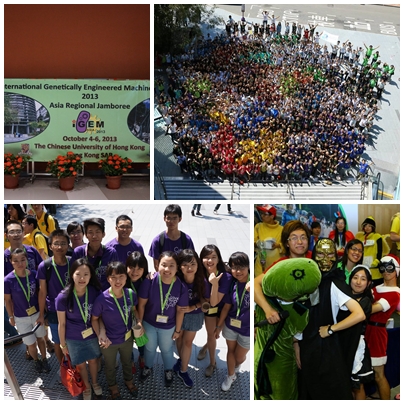
Additional Information:
26 October 2012
CUHK Students Win Gold Medal at iGEM Asia Again
Heading to US Next Month for World Championship
Following last year’s success, the iGEM (international Genetic Engineered Machine) team of The Chinese University of Hong Kong (CUHK) has won a gold medal again at the iGEM Asia Regional Jamboree, and is qualified to participate in the iGEM World Jamboree to be held at the Massachusetts Institute of Technology next month. The team consists of 9 students from the School of Life Sciences, 6 students from the Faculty of Engineering and 5 instructors. Since this May, the CUHK team had been devoted to preparing for the competition and developed the project completely by themselves, from defining themes, designing experiments to developing new parts and models from scratch. They demonstrated ample team spirit and efforts included publishing a wiki page, producing posters and introducing the project and the new devices on public occasions.
In their award-winning project ‘Light of No Return’, the CUHK team has created bacteria harbouring rhodopsin to attract cells with different light spectra for cell sorting. The idea is to allow bacteria to ‘see’ and sense light source, so that light could be used to attract or separate bacteria. This technology may be used to improve the efficacy of chemical treatment such as water sewage treatment. The team has also successfully made new biobricks with introduce ‘bacterial killing’ DNA to enhance biosafety. These bacterial killing biobricks can enhance biosafety by preventing the proliferation of transformed bacteria and antibiotic resistant bacteria, which are also known as the super bugs. For details of the project, please visit the following links:
http://2012.igem.org/Team:Hong_Kong-CUHK
http://2012.igem.org/files/presentation/Hong_Kong-CUHK.pdf
In addition, members of the CUHK team also organized various high school outreach activities to introduce to high school students the potential social implications and significance in academic research of genetic engineering and synthetic biology through talks and workshops, with an aim to enhance their understanding and to raise their interests in this field. The team will also introduce synthetic biology and their project to the public at the University’s Orientation Day on coming Saturday (27 October).
About iGEM Competition
iGEM is an annual premier synthetic biology competition for undergraduates worldwide. It was established by the MIT in 2004 to foster students’ learning in synthetic biology, promote collaboration among students and nurture biology talents. Participating teams are required to specify, design, build, and test simple biological systems made from standard, interchangeable biological parts. The accomplishments of these student teams often lead to important advances in medicine, energy, and the environment. For more information, please visit http://www.igem.org.
****************************************************************************************************
中大生再奪國際遺傳工程機器設計競賽亞洲區金獎
下月赴美參加世界賽
香港中文大學(中大)遺傳工程機器隊伍延續去年佳績,日前在國際遺傳工程機器設計競賽(iGEM)亞洲區比賽中再奪金獎,並將於下月赴美國麻省理工學院參加世界決賽。中大隊伍由9名生命科學學院的學生、6名工程學院學生及5名教練組成。他們自今年五月起已積極作好準備,由訂定題目到創造生物零件及模型,以及設計實驗,皆完全由學生自行創作。在亞洲區比賽當天,各隊員分工合作,除完成實驗外,還要製作網頁及海報,並在公開演說中講解其創作的課題,終獲得理想成績。
中大隊伍的參賽研究項目名為「見光不回頭」 (Light of No Return)。隊員別具創意,利用能夠辨別顏色的蛋白注入細菌內,把不能看東西的細菌加上可感光的「眼睛」。此構思可利用不同光譜吸引或者分離細菌,有助污水處理如吸收污染物或提高分解污染物的效益。中大隊伍同時引進了能注入基因片斷進行殺菌的新生物零件,提高生物安全性,可防止抗藥惡菌肆虐,亦可阻止轉基因細菌擴散,具醫療應用的價值。有關研究項目的詳細內容,可參考以下連結:
http://2012.igem.org/Team:Hong_Kong-CUHK
http://2012.igem.org/files/presentation/Hong_Kong-CUHK.pdf
此外,參賽隊伍成員於比賽後亦舉辦了中學外展活動,透過講座及實驗工作坊向高中生介紹遺傳工程及合成生物學技術,及其對社會或學術研究的貢獻,加深他們對此學科的興趣。隊員亦將於本周六(10月27日)舉行的本科生入學資訊日向公眾介紹有關知識。
iGEM比賽簡介
iGEM比賽為國際合成生物學界每年一度的盛事,專為本科生而設。iGEM由麻省理工學院於2004年創立,旨在促進學生在合成生物學的學習、交流與合作,以培養合成生物學人才。比賽隊伍須利用基本且可交替的生物部件,設計及建立有效的生物系統。參賽作品水平超卓,有效推動醫學、能源及環境等方面的發展。網址:http://www.igem.org。

Synthetic Biology Workshop for Secondary Schools
***********************************************************************
October 25, 2011
CUHK Undergraduate Students Win Gold Medal at iGEM Asia
Heading to US Next Month for World Championship
A genetic engineering team formed by undergraduate students of science and engineering at The Chinese University of Hong Kong (CUHK) recently won a gold medal at the iGEM (international Genetic Engineered Machine) Asia Regional Jamboree. They also won the Best BioBrick Measurement Approach and the Best New BioBrick Part (Natural) awards and were qualified to participate in the world championship of the iGEM Jamboree to be held at the Massachusetts Institute of Technology (MIT) in November, competing with over 50 teams from around the world. Prof. Ng Cheuk-yiu, Dean of Science; Prof. K.F. Wong, Associate Dean of Engineering; and Prof. Chu Ka-hou, Director of School of Life Sciences, today (25 October) presented certificates to the winning students in recognition of their outstanding performance.
The CUHK team comprises seven coaches and 24 undergraduate students, including 19 life sciences students, four engineering students and one chemistry student. This is the second year that CUHK students have participated in the competition. While participants last year were all from the School of Life Sciences, engineering students from Biomedical Engineering, Computer Science and Engineering and Electronic Engineering also joined the competition this year to conduct interdisciplinary synthetic biological research. With the theme of renewable energy, the CUHK team studied how the use of solar energy could solve certain problems in two major environmental issues: water and energy. Based on the idea that a bacterial halorhodopsin can use solar energy to drive the transport of chloride ion across the membrane, the team used sunlight to drive the ion channel to concentrate ion or desalt seawater for freshwater production and create electric current to produce electricity simultaneously.
The students’ work was greatly acclaimed by the panel of judges. One of the judges, Prof. Mukund Tattai of the National Centre for Biological Sciences (India), who presented the team with the Best BioBrick Measurement Approach award, commented that the team had done extensive characterizations to the BioBrick which is well ready for use by the research community. Another panel judge, Prof. Qi Ouyang of Peking University, who presented the team with the Best New BioBrick Part (Natural) award, commended the team’s creativity in making use of an ion transporter found in bacteria to generate electricity.
This is the first time that regional competitions of iGEM have been held in the US, Europe and Asia. A total of 42 teams from different universities joined the competition in Asia. Since this May, the CUHK team had been devoted to preparing for the competition and developed the project completely by themselves, from defining themes, designing experiments to developing new parts, models and biobricks from scratch. They demonstrated ample team spirit and efforts included publishing a wiki page, producing posters and introducing the project and the new devices on public occasions.
Prof. Chu Ka-hou emphasized that experiential learning beyond classroom was very important in nurturing talents. During the competition, students not only got an opportunity to show their creativity, but also learned the basic experimental skills through making biobricks or software. It also helped enhance their team spirit and time management skills. A biochemistry student, Gordon Chan, said, ‘iGEM offers us a rare opportunity to use some state-of-the-art technological instruments and polish skills that are beyond the formal curriculum, including experimental techniques, writing skills, leadership skills, social skills, statistical analysis and presentation skills. The heavy workload also trained up my perseverance.’
About iGEM Competition
iGEM is an annual premier synthetic biology competition for undergraduates worldwide. It was established by the MIT in 2004 to foster students’ learning in synthetic biology, promote collaboration among students and nurture biology talents. Participating teams are required to specify, design, build, and test simple biological systems made from standard, interchangeable biological parts. The accomplishments of these student teams often lead to important advances in medicine, energy, and the environment. For more information, please visit http://www.igem.org.
***********************************************************************
中大本科生奪國際遺傳工程機器設計競賽亞洲區金獎
下月赴美參加世界賽
由香港中文大學(中大)理學院及工程學院本科生組成的基因工程隊伍日前在國際遺傳工程機器設計競賽(iGEM)的亞洲區比賽中榮獲金獎,並同時獲頒最佳生物新天然零件及最佳零件實驗量度兩項大獎,取得晉身世界賽的入場券,將於下月赴美國麻省理工學院參加iGEM決賽,與全球五十多隊隊伍一較高下。中大理學院院長伍灼耀教授、工程學院副院長黃錦輝教授和生命科學學院院長朱嘉濠教授今天(10月25日)頒發獎狀予各得獎同學,並讚揚他們的傑出表現。
中大隊伍由七名教練及廿四名同學組成,包括十九名生命科學學院的學生、四名工程學院學生及一名化學系學生。中大生命科學學院去年首度參賽,今年更首度加入工程學院的學生,他們分別來自生物醫學工程學課程、計算機科學與工程學系和電子工程學系,與理學院學生一起進行跨學科的合成生物學研究。中大隊伍的參賽項目以再生能源為題,使用太陽能改善水源和能源兩大環境問題。基於細菌內的感光離子通道可透過太陽能來輸送氯離子,中大隊伍開發的項目利用太陽光照促使細菌吸收離子,一方面吸走水中鹽份有助海水化淡,同時可產生電流來發電。
評審小組對中大的項目讚賞不已,來自印度國立生物科學中心的達泰牧艾教授在頒發最佳零件實驗量度大獎時表示,中大隊伍所開發的生物零件經過同學的詳細分析後,現已適合提供給其他研究人員使用。另一評審,來自北京大學的歐陽頤教授在頒發生物新天然零件大獎時,特別讚揚使用細菌感光離子通道來發電的構思十分具創意。
今年,賽會首次在美洲、歐洲及亞洲舉辦iGEM分區賽,亞洲區共有四十二隊來自不同大學的隊伍參賽。中大隊伍自今年五月起積極籌備比賽,由訂定題目、設計實驗,到創造生物零件、模型及化學零件,皆完全由同學自行構思。隊員分工合作,既順利完成了實驗,還在互聯網上發表維基網頁、印製海報,並在公開演說中講解其構思的課題及創作的新零件。
朱嘉濠教授強調,課堂以外的學習經歷對培養人才十分重要,是次比賽為同學提供發揮無限創意的空間,讓他們在親自製作生物零件或編寫軟件的過程中學會基礎實驗的技術,更實踐了時間管理及團隊精神。來自生化課程的陳灝晴同學表示:「iGEM比賽讓我有機會使用一般本科生難以接觸到的嶄新科技儀器和技術,還可學習到多項課程外的技巧,如做實驗、寫作、領導能力、社交、統計分析、表達技巧等;繁重的工作量亦使我的毅力得到很好的鍛鍊。」
iGEM比賽簡介
iGEM比賽為國際合成生物學界每年一度的盛事,專為本科生而設。iGEM由麻省理工學院於2004年創立,旨在促進學生在合成生物學的學習、交流與合作,以培養合成生物學人才。比賽隊伍須利用基本且可交替的生物部件,設計及建立有效的生物系統。參賽作品水平超卓,有效推動醫學、能源及環境等方面的發展。網址:http://www.igem.org。
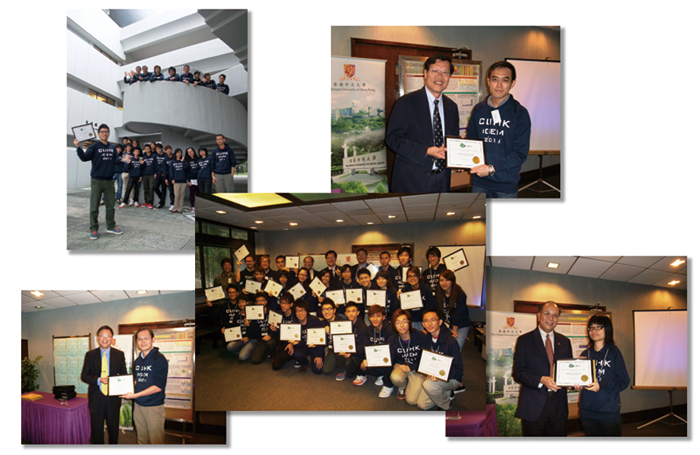
Biochemistry Students Win Gold at MIT Competition
for Proving Bacteria DNA as Device for Information Storage
(24 Nov. 2010)
A team of 11 students from the Biochemistry programme of the School of Life Sciences at The Chinese University of Hong Kong (CUHK) won gold at the International Genetically Engineered Machine (iGEM) 2010 competition organized by the Massachusetts Institute of Technology (MIT) in the US. Under the supervision of Prof. Chan King-ming, Prof. Chan Ting-fung and Prof. Kong Siu-kai of the School of Life Sciences, the CUHK team significantly advanced the use of bacteria for information storage by strengthening its storage capacity and security system. An innovative biological cryptography system for application in DNA is developed to protect information leakage, heralding a new era of information security.
At a celebration held today (24 November), Prof. Joseph J. Y. Sung, CUHK Vice-Chancellor, congratulated the students and the newly-established School of Life Sciences on their achievement. ‘The competition encourages students to develop research projects to benefit mankind with their creativity and wisdom. It also broadens their horizons by promoting inter-disciplinary learning.’
Using bacteria as an information storage device was proposed about a decade ago. However, the award-winning CUHK team was the first to use the plasmid DNA of Escherichia coli to encrypt and store information not only in the form of text, but also in the forms of images, biological barcodes, etc.
In order to store a massive amount of data, the team proposed to fragment the information and store them in bacteria. A novel information processing system was invented to reconstruct the original information. With this technology, it is estimated that one gram of bacteria can store data of up to 900,000 GB (gigabytes), which is equivalent to 450 hard drives, each with 2 TB (terabytes) of storage capacity. The biocryptography system has a great potential for long term and large scale data storage, and is also applicable to the production of genetically modified food and organisms.
Prof. Chan King-ming is very pleased with the students’ result. ‘The team was formed early this year, and members have spent endless hours during the past 10 months developing the research project from scratch – from designing experiments, testing out the idea, to creating a website and poster, and presenting in front of a panel of judges.’ The team was led by three instructors – Yu Chi-shing, Li Jing-woei and Yim Kay-yuen Aldrin, and was composed of eight students – Loo Fong-chuen Jacky, Choi Ricky Thomson, Chu Tin-yi, Wong Kit-ying, Chiu Wai-yin Vivien, Mak Ka-yan Cathy, Liu Si-si Sophie and Wong In-chun Ada.
About iGEM Competition
iGEM is the premier synthetic biology competition for undergraduates worldwide. It began in January 2003 as a month-long course for students to design biological systems, and grew into a competition in 2004. For iGEM 2010, 138 teams with over 1,900 participants from around the world took part. They are required to specify, design, build, and test simple biological systems made from standard, interchangeable biological parts. The accomplishments of these student teams often lead to important advances in medicine, energy, and the environment.
For more information, please visit http://www.igem.ord
